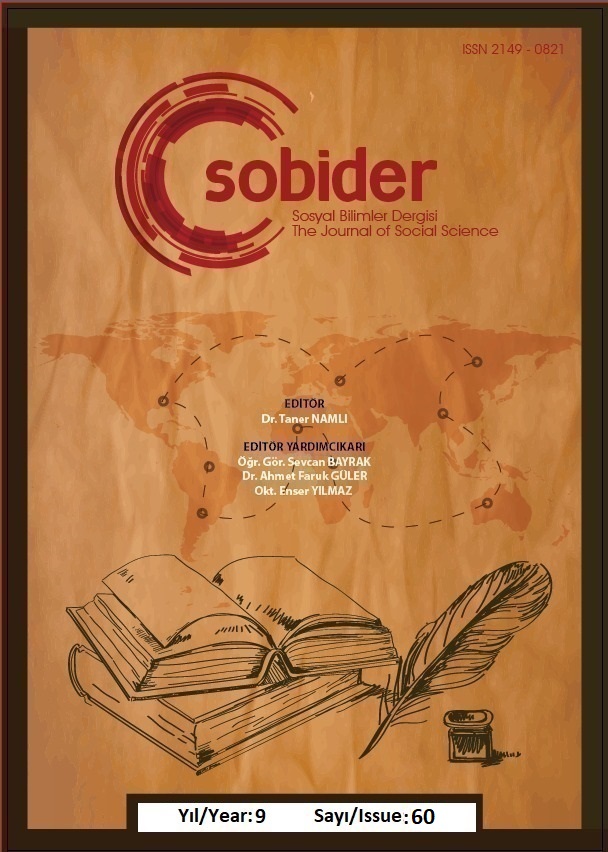Author :
Abstract
Işığın bir elementi olan renk mağara resminden günümüze kadar resim sanatında varlığını ve önemini sürdürmüştür. Yüzey üzerine uygulanan resim sanatında renk, gerek çizgisel gerekse de lekesel ifadelerde anlam ve içerik açısından form ile birlikte kullanılan resmin temel elamanlarından biridir. Renk, fizik, psikoloji, sosyoloji ve felsefe gibi düşünce temelli disiplinlerde anlam bulmuştur. Tecrübe ve bilginin sınırları içinde hareket eden ‘renk’ tarih boyunca kuramsal ve pratik bir olgu olmuştur. Sanat tarihine bakıldığında, Rönesans’ın bilime dayanan icatlarıyla yeni özellikleri ortaya çıkan renk, ışık – gölge oyunlarını mümkün kılarak perspektif ve hacim duygusu yaratmıştır. Özellikle empresyonist süreçte ve sonrasında rengin bağımsızlığını ilan etmesi, renge atfedilen önemi daha da arttırmıştır. Empresyonist öncesi süreçte renk resimsel kompozisyonlarda bir araç durumunda iken empresyonizmle birlikte rengin bağımsız ve özerk bir eleman olduğu keşfedilmiştir. Araştırmanın esas odağını oluşturan renk olgusuyla birlikte rengin form ve yüzeyle olan ilişkisine de değinilmiştir. Rengin fiziksel ve fizyolojik özellikleri irdelenerek dönemler içerisindeki renk kullanımları görsellerle desteklenerek sonuca varılmıştır.
Keywords
Abstract
Color, which is an element of light, has continued its existence and importance in the art of painting from cave painting to the present day. In the art of painting applied on the surface, color is one of the basic elements of painting, which is used together with form in terms of meaning and content in both linear and spot expressions. Color has found meaning in thought-based disciplines such as physics, psychology, sociology and philosophy. ‘Color’, which moves within the boundaries of experience and knowledge, has been a theoretical and practical phenomenon throughout history. Looking at the history of art, it has created a sense of perspective and volume by enabling the plays of color, light and shadow, new features of which emerged with the inventions of the Renaissance based on science. Especially in the impressionist process and after the declaration of the independence of color, the importance attributed to color has increased even more.While color was a tool in pictorial compositions in the pre-Impressionist period, it was discovered that color is an independent and autonomous element with impressionism. Along with the color phenomenon, which constitutes the main focus of the research, the relationship of color with form and surface is also touched upon. By examining the physical and physiological properties of color, the results were reached by supporting the use of color in the periods with visuals.
Keywords
- Agoston, George A. (2013). Color Theory and Its Application in Art and Design, Springer.
- Aktaş, İ. (2019). Resim Sanatında Yüzey, Figür Ve Geometriksel Form İlişkilendirmelerine Yönelik Arayışlar, Yüksek Lisans Tezi, İnönü Üniversitesi, Malatya.
- Albers, J. (2020). Rengin Etkileşimi, İstanbul, Hayalperest Yayınevi. Altuğ Taşkanal, G. (2015). İki Boyuttan Üç Boyuta Modern Resimde Yüzey Sorgulaması, Yüksek Lisans Tezi, Atatürk Üniversitesi, Erzurum.
- Aslıhan, S,G. (2006). Günlük Yaşamın Basit Olguları’ndan Hareketle Resimde Form- Renk İlişkisi’nin Çağdaş Grafik Anlatım Aracılığıyla Çözümlenmesi, Yüksek Lisans Tezi, Antalya.
- Ateş, D. Bayav, E. (2011). 20. Yüzyıl Resim Sanatında Yüzeyin Sınırlarını Aşan Arayışlar . Sanat ve Tasarım Dergisi , 1 (8) , 35-57
- Bleicher, S. (2012). Contemporary Color: Theory and Use Delmar, Cengage Learning.
- Brusatin, M. (1991). A History of Colors. Boston : Shambhala ; New York : Distributed in the U.S. by Random House.
- Crone, Robert A. (1999). A History of Color. Dortrecht, Springer Netherlands.
- Çağlayan, E.(2018). Temel Sanat Eğitiminde Renk Olgusu , İnsan ve Toplum Bilimleri Araştırmaları Dergisi, 7: 22-34
- Erim, G. (2000). Rengin,Psikolojik Etkileri, Uludağ Üniversitesi Eğitim Fakültesi Dergisi, Cilt: Xlll, Sayı: 1, 11-15
- Erzen J., “Yeni Gerçekçiler”, Eczacıbaşı Sanat Ansiklopedisi, Yapı Endüstri Merkezi Yayınları, İstanbul, (1997) , 1932.
- Eyüboğlu, Bedri Rahmi. Resme Başlarken, Bilgi Yayıncılık, Ankara., 1986.
- Fine, A. (2021). Color Theory: A Critical Introduction, Bloomsbury Publishing.
- Gürtuna, S. (2007). Çocuğum Sanatla Tanışıyor. İstanbul: Morpa Yayınları
- Harmanci, A. (2018). Resimde Renk Olgusu. Yüksek Lisans Tezi, Erzurum;Atatürk Üniversitesi Sosyal Bilimler Enstitüsü
- Kısaoğulları Cançat, A.(2016). Görsel Sanat Eğitiminde Yüzey Teknikleri Ve Anlam Problematiği. Sed,4 (1), s.19-36
- Orna, Mary V. (2012). The Chemical History of Color , Springer Science & Business Media
- Özdemir, E. ve Başkaya, A. (2005). Tarihsel Süreçte Kamu Yapısı Cephesi: Ulus- Sayıştay ve Ankara Ticaret Odası, 2.National Çatı Cephe Malzemeleri ve Teknolojileri Sempozyumu, İstanbul,157-164. Per, M. (2012). Renk Teorilerine Tarihsel Bir Bakış, Yedi: Sanat, Tasarım Ve Bilim Dergisi, 8: 17-26
- Riley, Charles A. (1995). Color codes : modern theories of color in philosophy, painting and architecture, literature, music and psychology, Hanover, NH : University Press of New England.
- Temizsoylu, Nuri (1987). Renk ve Resimde Kullanımı, İstanbul: Mimar Sinan Üniversitesi Yayınları.
- Tokdil, E. (2016). Renk Kuramları ve Andre Lhote Örnekleminde Renk Algısına Fenomenolojik Yaklaşım. idil, 5 (22), s.547-568.
- Whyte, Lancelot L, (1951) . Aspects of form; a symposium on form in nature and art, [London] Lund Humphries
- Zelanski, P. (1999). Color, Upper Saddle River, N.J. :Prentice Hall.
- Resim 1: Lascaux Mağarası Duvar Resimleri, Fransa, Erişim Tarihi : ( 15. 10. 2021 ) https://ozkanirman.com/site/2017/01/22/altamira-ve-mustafakemalpasa/
- Resim 2: Bleicher, S. (2012). Contemporary Color: Theory and Use, s.5, Delmar, Cengage Learning. Erişim Tarihi : 21.10.2021
- Resim 3: Bleicher, S. (2012). Contemporary Color: Theory and Use, s.43, Delmar, Cengage Learning Erişim Tarihi : 23.10.2021
- Resim 4: https://books.google.com.tr/books?id=3OnTgJ9iyYYC&pg=PA98&hl=tr&source =gbs_selected_pages&cad=2#v=onepage&q&f=false Erişim Tarihi : 24.10.2021
- Resim 5: https://drawpaintacademy.com/form/ , Erişim Tarihi: 15.10.2021
- Marder,, L. (2020), The Definition of 'Form' in Art, https://www.thoughtco.com/definition-of-form-in-art-182437 , Erişim Tarihi: 15.10.2021
- Scott, D. (2020), Form in Art – How to Use It Effectively (And Avoid “Flat” Artworks), https://drawpaintacademy.com/form/ , Erişim Tarihi: 15.10.2021





